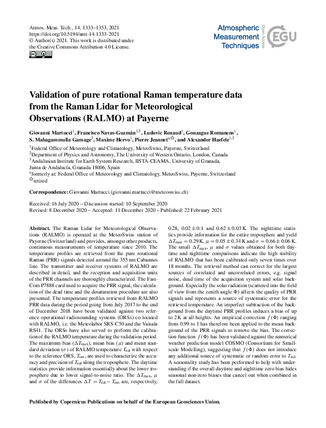The Raman Lidar for Meteorological Observations (RALMO) is operated at the MeteoSwiss station of Payerne (Switzerland) and provides, amongst other products, continuous measurements of temperature since 2010. The temperature profiles are retrieved from the pure rotational Raman (PRR) signals detected around the 355 nm Cabannes line. The transmitter and receiver systems of RALMO are described in detail, and the reception and acquisition units of the PRR channels are thoroughly characterized. The FastCom P7888 card used to acquire the PRR signal, the calculation of the dead time and the desaturation procedure are also presented. The temperature profiles retrieved from RALMO PRR data during the period going from July 2017 to the end of December 2018 have been validated against two reference operational radiosounding systems (ORSs) co-located with RALMO, i.e. the Meteolabor SRS-C50 and the Vaisala RS41. The ORSs have also served to perform the calibration of the RALMO temperature during the validation period. The maximum bias (ΔTmax), mean bias (μ) and mean standard deviation (σ) of RALMO temperature Tral with respect to the reference ORS, Tors, are used to characterize the accuracy and precision of Tral along the troposphere. The daytime statistics provide information essentially about the lower troposphere due to lower signal-to-noise ratio. The ΔTmax, μ and σ of the differences ΔT=Tral−Tors are, respectively, 0.28, 0.02±0.1 and 0.62±0.03 K. The nighttime statistics provide information for the entire troposphere and yield ΔTmax=0.29 K, μ=0.05±0.34 K and σ=0.66±0.06 K. The small ΔTmax, μ and σ values obtained for both daytime and nighttime comparisons indicate the high stability of RALMO that has been calibrated only seven times over 18 months. The retrieval method can correct for the largest sources of correlated and uncorrelated errors, e.g. signal noise, dead time of the acquisition system and solar background. Especially the solar radiation (scattered into the field of view from the zenith angle Φ) affects the quality of PRR signals and represents a source of systematic error for the retrieved temperature. An imperfect subtraction of the background from the daytime PRR profiles induces a bias of up to 2 K at all heights. An empirical correction f(Φ) ranging from 0.99 to 1 has therefore been applied to the mean background of the PRR signals to remove the bias. The correction function f(Φ) has been validated against the numerical weather prediction model COSMO (Consortium for Small-scale Modelling), suggesting that f(Φ) does not introduce any additional source of systematic or random error to Tral. A seasonality study has been performed to help with understanding if the overall daytime and nighttime zero bias hides seasonal non-zero biases that cancel out when combined in the full dataset.
Title
Validation of pure rotational Raman temperature data from the Raman Lidar for Meteorological Observations (RALMO) at Payerne
Authors
Martucci, G., Navas-Guzmán, F., Renaud, L., Romanens, G., Gamage, S. M., Hervo, M., Jeannet, P., and Haefele, A.
Published
by Atmospheric Measurement Techniques (AMT) at 2021-02-22
Abstract
